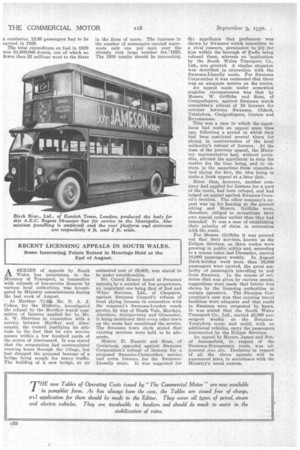PARIS PUBLIC - TRANSPORT AFFAIRS. Interesting Facts and Figures Relating to the Service, Affording a Comparison With Previous Years.
Page 59

Page 60

If you've noticed an error in this article please click here to report it so we can fix it.
AT the recent annual general meetinging of the Societe des Transports en Commun dans is Region Parisienne, as the Paris surfacestrahaport concern styles itself, M. Manage, the DirecteurGeneral, foreshadowed a revision of the existing contract under which the T.C.R.P. runs buses, trams and river steamers on what corresponds virtually to a hire-purchase arrangement.
Whilst the present agreement is highly satisfactory to shareholders in the original public-transport companies, which were amalgamated and taken over by the Seine Council in 1920, the financial results for the council and, ipso facto, for the ratepayers, have been little short of disastrohs. The deficit on working shown by the T.C.R.P. for 1929 is 42,450,000 francs, but the concern continues to distribute 9,000,000 francs in
" dividends " to its shareholders, who are the shareholders of the old companies.
Trams and heavy interest on a big permanent loan account for much of the loss, but the need for a general overhaul of the working system seems to be indicated. It is true that tram services are very gradually being replaced by bus lines, but the change is proceeding so slowly that at the present rate all living Paris ratepayers will have long since Passed away before the last tramcar clangs and bumps itself out of the city.
The Paris public is wonderfully patient, quite astonishingly so when one thinks of the quick-tempered Latin character found in the average Frenchman individually, but it would seem that the worm is about to turn at last. M. Mari
age is busy elaborating a new scheme under which a certain credit will be voted by the council each year for the T.C.R.P., and this credit must not be exceeded.
Up to the present the ratepayers have had to make good the whole of the lose on the uneconomic working of their public transport, but the new arrangement will limit the financial responsibility of the council, in theory at any rate. In justice to the council and the directors of the T.C.R.P. it should he mentioned that interest on the original loan raised in 1920, when the council took over the companies' accounts, forms a large part of the annual deficit . on working. The council borrowed 400,000,000 francs in the United States at 8i per Cent. when the American exchange stood at 12 francs to the dollar. The rate is now 25 francs to the dollar.
Some very interesting statistics with regard to the working of the T.C.R.P. are given in thia year's report.
Expenditure for 1929 was 713,000,000 francs and receipts were 675,000,000 francs, representing 1,034,000,000 passengers carried.
Fuel consumption averaged 46.8 litre3 per 100 car-kilometres; that is to say, just over six miles per gallon. It may be mentioned that Paris buses run on a half-and-half mixture of petrol and commercial alcohol. This fuel has been in use for the past 10 years. and appears to give very satisfactory results.
Pneumatics, which are now fitted to a large proportion of the buses, show an average life of 46,200 kilometres. The great advance made in tyre construction during recent years is particularly noted, as the first pneumatics fitted in 1924 only averaged 21,700.. kilometres.
Some interesting comparisons are made with pre-war figures for the running costs of the buses. In 1913 the average working hour for the personnel cost 85 centimes. In. 1929 it cost 8 francs 47 cm.! This does not mean,' however, that employees receive 9.92 times their pre-war pay. They work shorter time and get many more paid holidays. The result, from the point of view of running costs, is that whilst in 1913 5.68 passengers had to be carried in order to pay one working hour for a conductor, 12.68 passengers had to be carried in 1929.
The total expenditure on fuel in 1929 was 51,000000 francs, out of which no fewer than 23 millions went to the State in the form of taxes. The increase in the number of passengers carried represents only one per cent, over thg already very large number for21928. The 1930 results should be interesting.












































































































